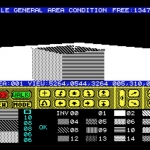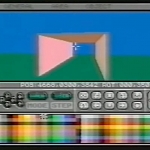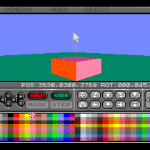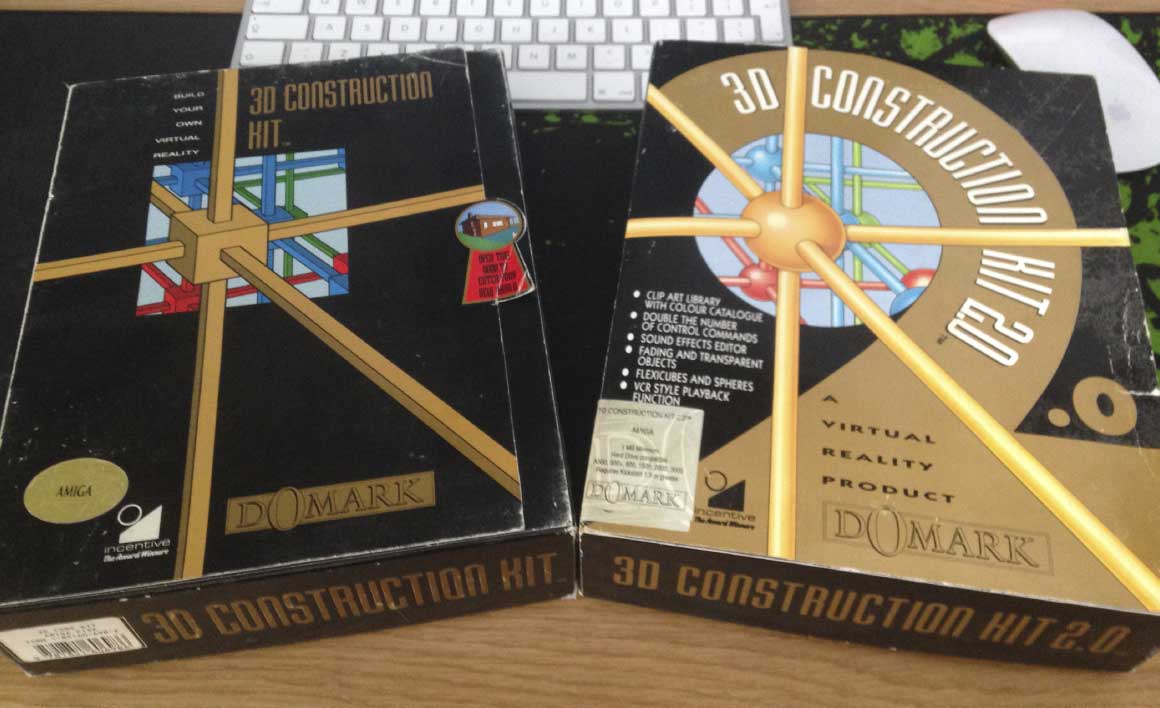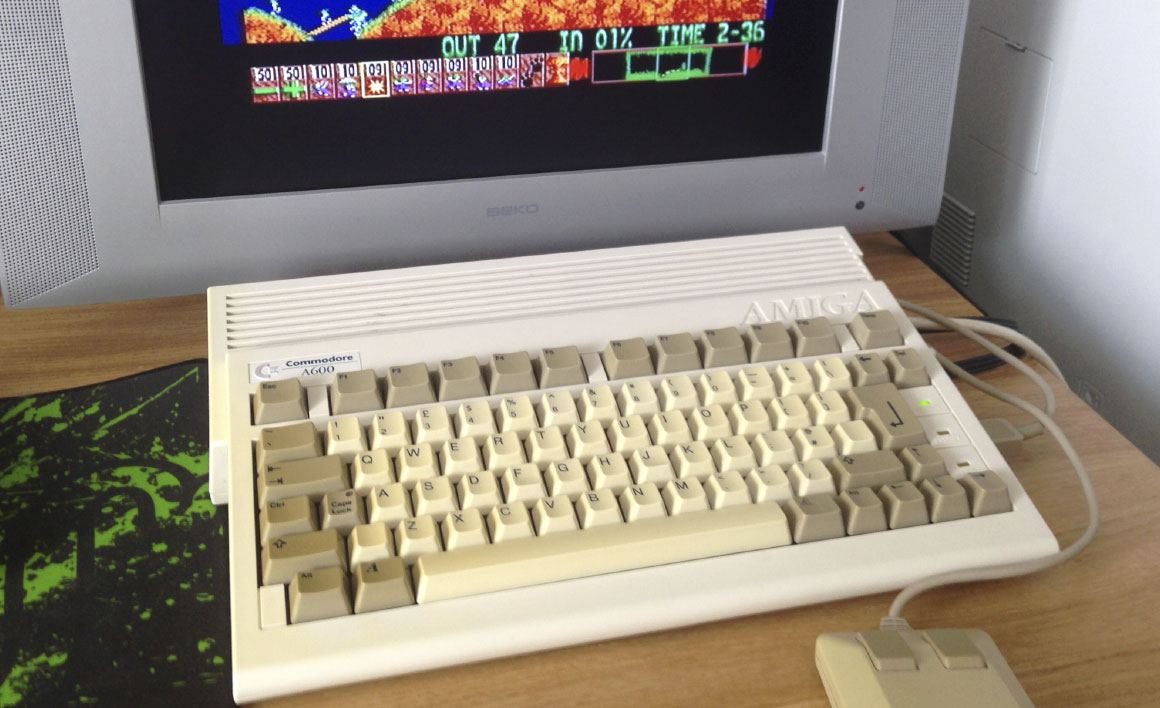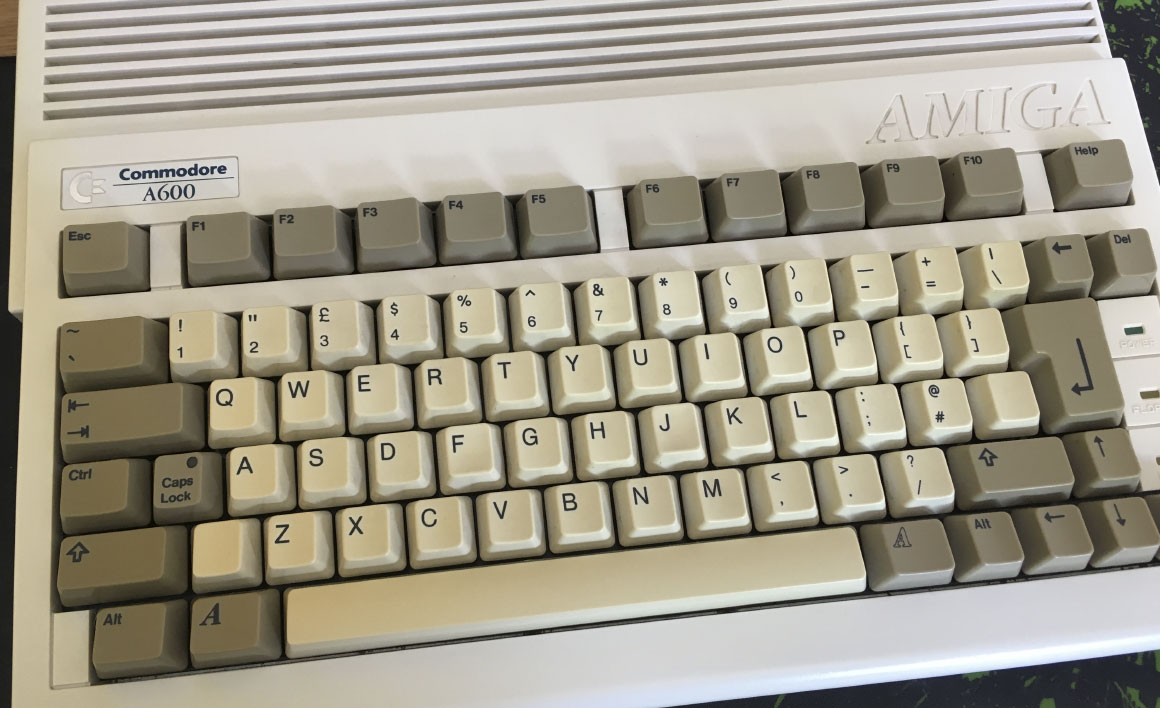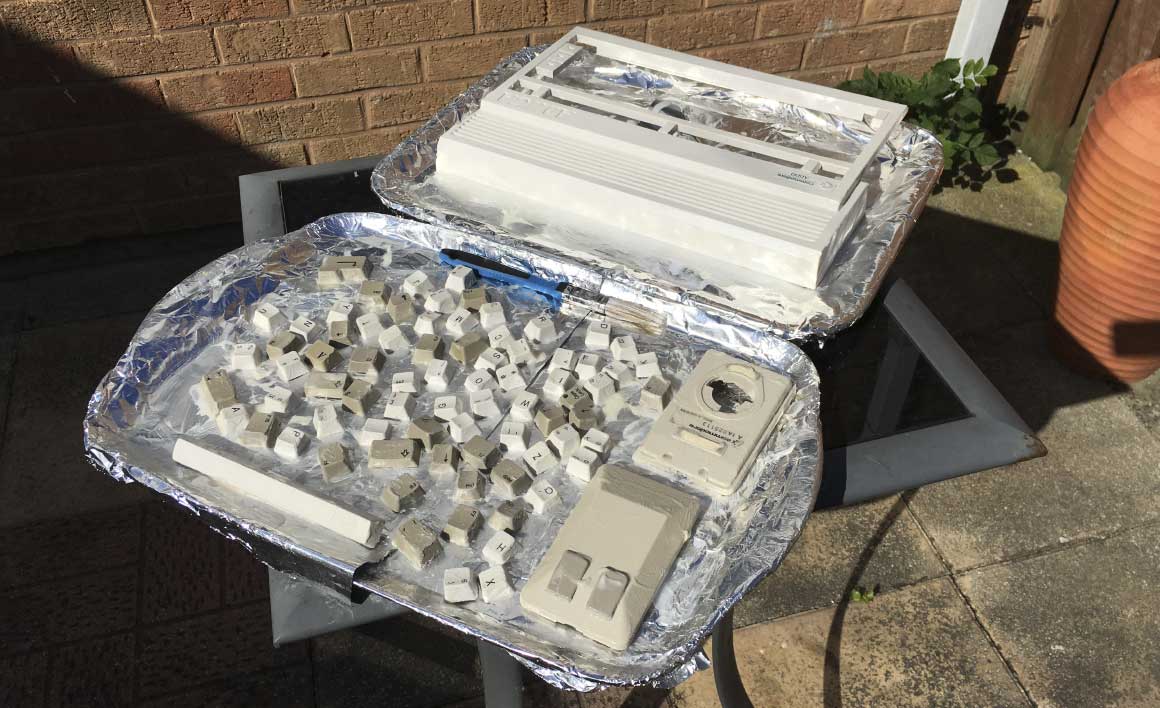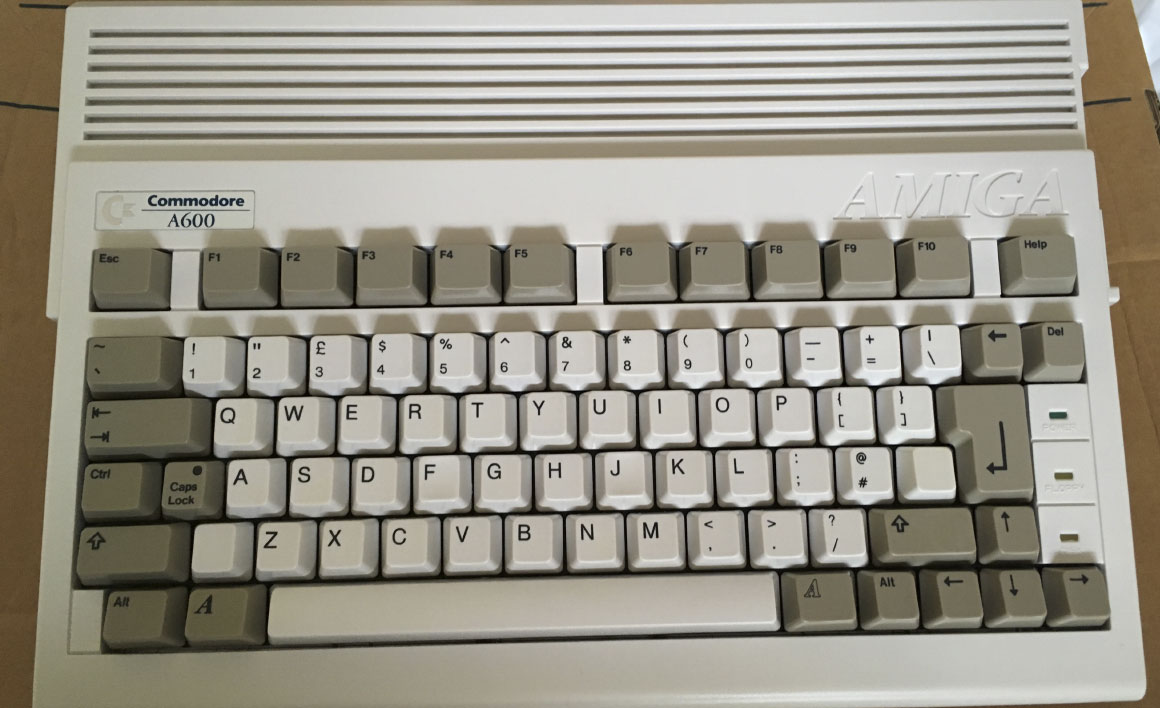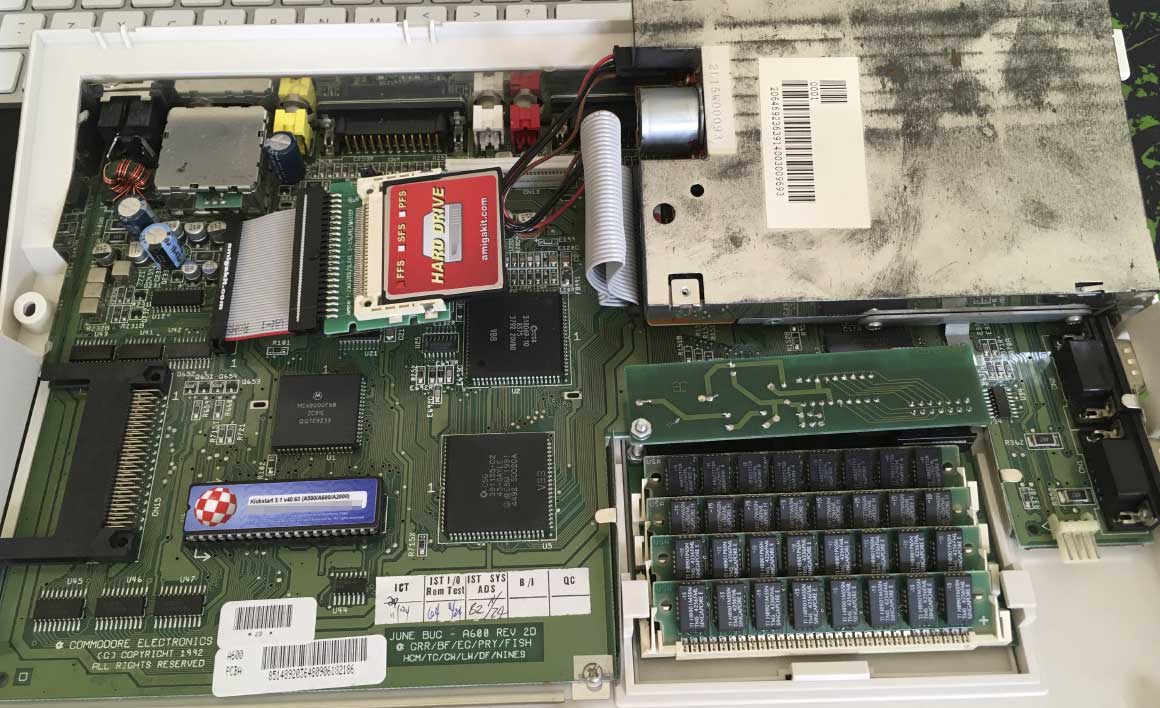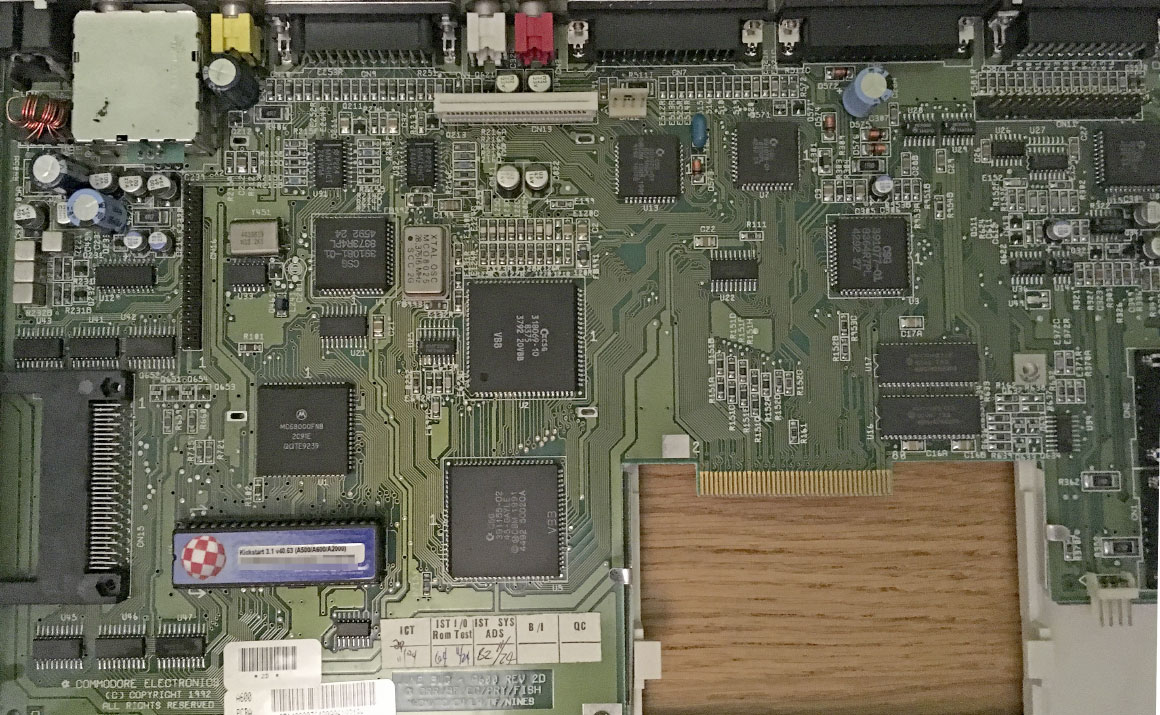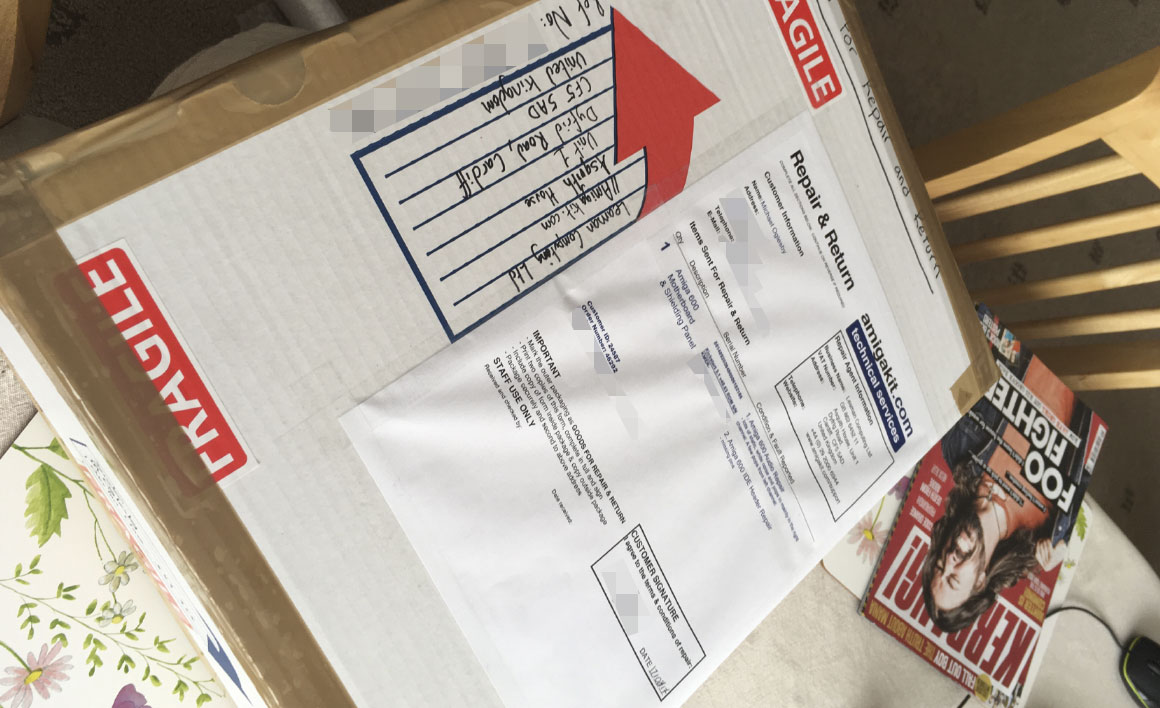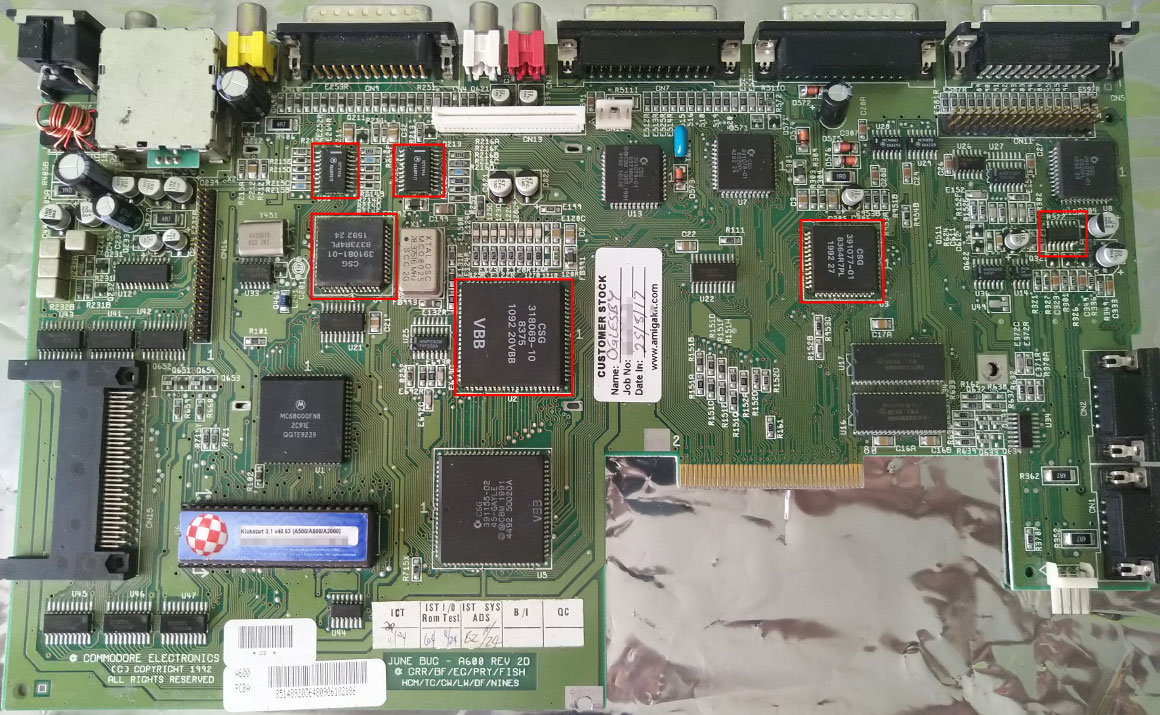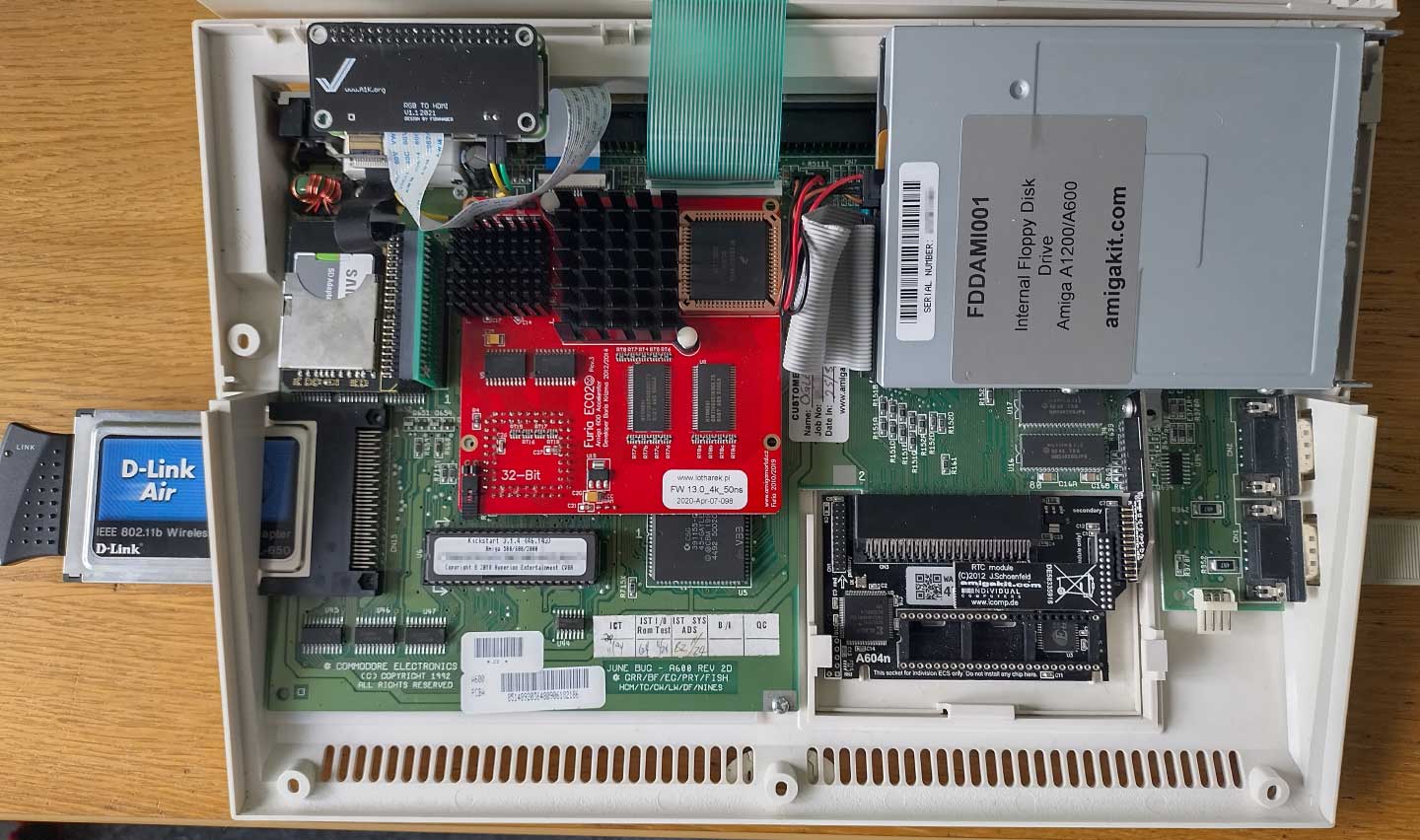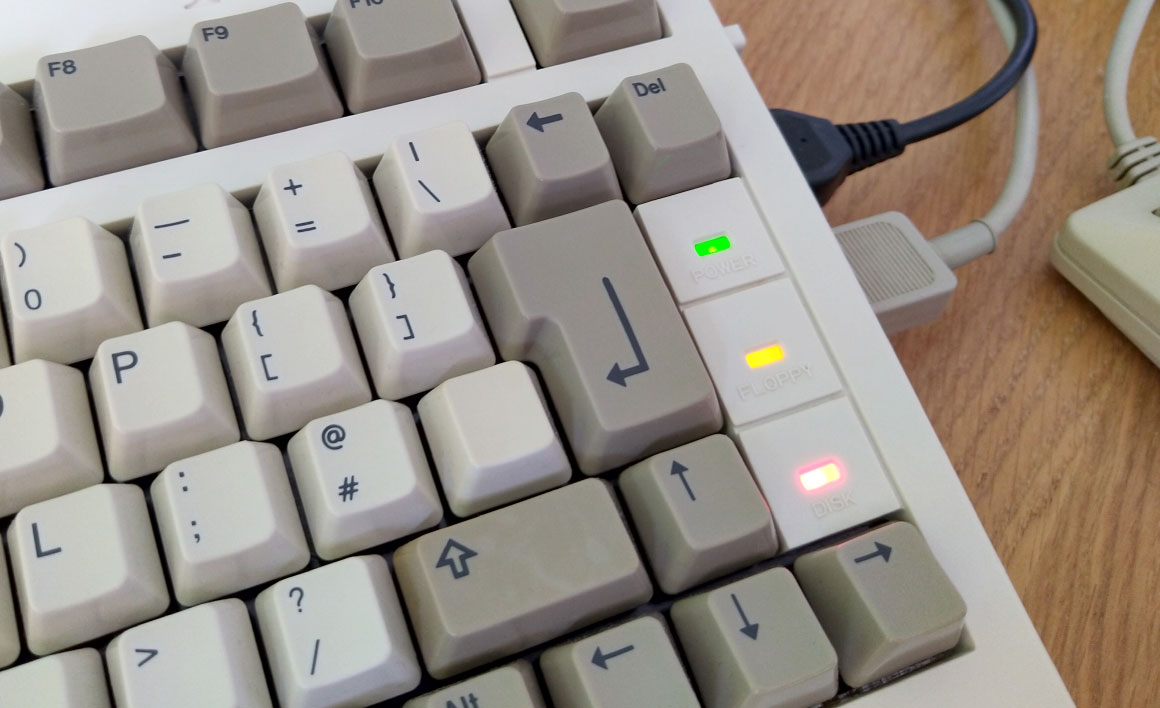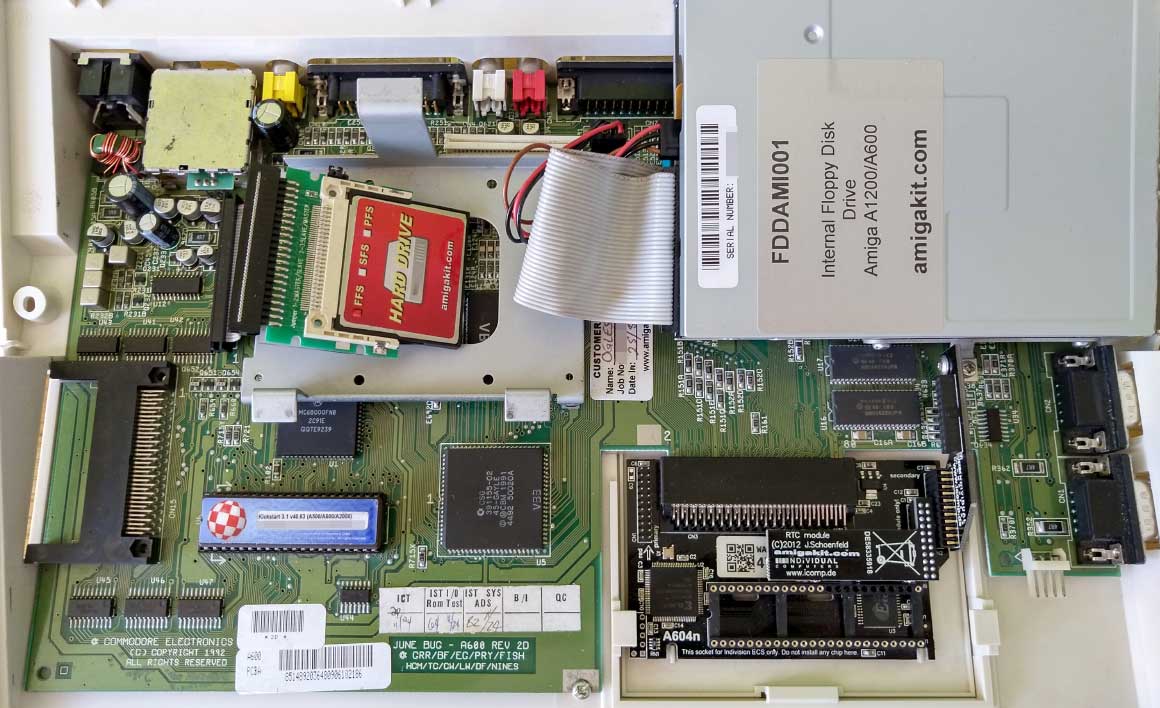My Amiga 600 Project: The Ups and Downs
History
In the early 1990s, I received a Sinclair ZX Spectrum 128K for Christmas, a fantastic 8-bit machine by the way, and yes, the Spectrum does have colour clash, but let’s be honest, the games were a lot better on the Spectrum than on the Commodore 64 or Amstrad CPC. I loved playing on my Speccy, classics such as RoboCop, Target: Renegade, and Magicland Dizzy; hours of fun. One day, after school, my brother came home with a boxed copy of Driller by Incentive Software. Driller was the first of its kind for the Spectrum, a space adventure puzzle game whereby you can move around the game environment in full, solid 3D graphics, no graphical tricks, no isometrics views, no wireframes views like in Elite, no forced perspective, proper solid 3D graphics. OK, admittedly the frame rate was very poor, literally one frame per second, but the game created shockwaves within the 8-bit world. Incentive Software had created the remarkable, a fully 3D game within 48K of RAM, impressive!
After the massive success of Driller, Incentive released additional games based on their 3D engine, Freescape: Dark Side, Total Eclipse 1 and 2 and Castle Master 1 and 2. This inevitably led Incentive to release a Freescape application called 3D Construction Kit, a software tool whereby you could create your own worlds and games.
I was hooked.
Create your own worlds, games and puzzles in full 3D, I’ll have some of that! You have to remember, this is the 90s, and 3D graphics were only accessible to professionals with very expensive hardware and software. 3D Construction Kit put the power of 3D graphics (although in a primitive form), into the hands of the bedroom programmer.
3D Construction Kit came out as a complete software package: multiple tapes, a massive manual and a 30 minutes VHS tutorial video to boot, all with a price tag to match: £24.99 for the 8-bit version, £49.99 for the 16-bit version; that was a lot of money back then! So much so in fact, I couldn’t afford to buy the Spectrum version (I was poor), so I had to copy it from my brother’s friend.
3D Construction Kit was fantastic, I loved it, I even create a proper fully fledged game with it. I learned so much from the software, how to create objects in 3D and the basics of computer programming. The tutorial video was extremely helpful, giving insights on how to use the software and the command language, but what impressed me more wasn’t the video per se but the computer the tutorial was done on: a Commodore Amiga. Naturally, I’ve heard of the Amiga, it was a proper expensive 16-bit computer/games machine, with a mouse I might point out, but after watching the video I was totally blown away by the number of colours on offer, a faster frame rate, the interface, wow. The Spectrum version of 3D Construction Kit was limited to only a two-colour environment; this was a limitation of the hardware, so the application used ‘shades’ to colour objects, and it was slow, about one to two frames a second. When I watched the video and saw the Amiga version, I knew I had to have one. But there was no way I could afford one. If I couldn’t afford a proper copy of the software, how the hell could I afford an Amiga as well as the Amiga version of 3D Construction Kit? I eventually got a part-time job working in retail, so I started to save up. Then, Commodore released the Amiga 600, a more affordable version of the Amiga, and a more adorable version of the computer with its small form factor as well as the more advanced features over the 500 and 500+ models. Result. But alas, I never did quite manage to save up for an Amiga 600 for one reason or another, and the Amiga 600 was discontinued, I pass my A-Levels and I went to university.
Buying an Amiga… at long last
Time past. The year is 2000, I’ve graduated and I’m in my first full-time job, which meant I had some real money in my back pocket for the first time in my life. Then I discovered eBay. So, I started to search for things, mainly toys from my childhood that I’ve always wanted, or collected, like my Fighting Fantasy Collection. I’ve always wanted an Amiga 600 as previously mentioned, so I did a search and loads came up. I found a local seller and bought his Amiga 600, with memory expansion and Real Time Clock, some games, manuals and two joysticks for £50. Sorted. I then bought a copy of 3D Construction Kit 1 and 2 for the Amiga off eBay for like £10 each. I was living my dream at long last.
I played with my Amiga with 3D Construction Kit and games for a while, but unfortunately, it always ended up back in the box as I was renting at the time. Eventually, in 2011, I bought my own home, but Amiga still stayed in the box. What a war crime! I didn’t have much spare time. I had a lot of home repairs and decorating to do, as well as a full-time job and to make matters even more complicated, I got married. It wasn’t until much later that my interest in my Amiga came back in a big way.
It’s 2016. I had noticed over the years that my Amiga was becoming more and more yellow, a curse of old computers because of their fire-resistant plastic. Then, surfing YouTube one week, I saw an 8-Bit Guy video suggestion on how to restore your yellowed retro computer case back to its former glory by a process called Retrobrighting. Well, I was sold. So, I Retrobrighted my Amiga with amazing results and at the same time, I started searching YouTube for other Amiga-related content. I came across a video by Dan Wood in whereby he was reviewing his Amiga 600 and the modifications he had done to it. I was amazed. I didn’t know nor realise you could ‘mod’ or upgrade the Amiga 600 to the point of pushing it beyond what it was originally designed for. I watched the video a couple of times, noting down all the important things and went to straight AmigaKit to buy the upgrades, like an IDE Compact Flash adapter.
Houston, we’ve got a problem… or two
After purchasing and installing a few upgrades, I started to use my Amiga again and that’s when I noticed a problem with it. When I played games with music, like Lemmings 2 and Lotus III, I kept hearing distortion and pops in the sound channels. I initially thought it was due to the crap TV I had my Amiga hooked up to, but having got an Amiga RGB to SCART cable with sound composite (as I was previously using the RF port) and hooked it up to a decent TV, the sound distortions were still there.
I reached out to Dan Wood who amazingly replied and he told me to get my Amiga ‘recapped’. Recapped, also known as recapping, is a process whereby the capacitors on the PCB motherboard are replaced because they are old and don’t work as effectively as they once did.
So, I contacted a recap guy, hired his services and explained to him the sound distortion problem; he replied and said he’ll ‘take a look’. He recapped the board as requested, but unfortunately, the recap did not resolve the sound distortion problem and he didn’t know what was causing the sound problem either. So, I received my board back and I notice some of the IDE connectors pins were bent. When I tried to bend them back they just broke off or fell out altogether. I don’t blame the recap guy for this as these could have happened in shipping.
Nevertheless, there I was with an Amiga with a sound distortion problem and a broken IDE connector for my internal Compact Flash hard disk. By this time, having bought upgrades from AmigaKit, I knew they offered Amiga repair services, more specifically, IDE Connector replacement and Amiga 600 Audio Repair. So, on Thursday 17th August 2017, I bought these two services from the AmigaKit website, with collection/return courier services and insurance, all in all, £84.59 (£37.73 of that is shipping and insurance).
I packed my Amiga board, with its RF shield, in an antistatic bag, wrapped in bubble wrap within a reinforced postal box; I wasn’t taking any chances this time. As I had purchased a courier collection and return service, I assumed AmigaKit would contact me or arrange via the courier a collection date. Nope. After two weeks or so of waiting, I contact AmigaKit and gave them a ‘nudge’, this should have been a warning sign for things to come.
Eventually, the courier came and the courier went with my packed Amiga board and that was the last I saw of it for 22 months.
Just the facts Madam
The courier came and collected on 5th September 2017. I was hoping for my Amiga back for Christmas. I don’t know what made me think this, but it’s what I was hoping for. Having watched many retro computer repair/restoration videos on YouTube, I got the impression electrical component replacement jobs don’t take very long to perform.
Three months passed and shortly before Christmas, 9th December 2017, I politely contacted AmigaKit requesting an update on my repair; they didn’t reply until 5th January 2018:
The problem is, I had to remove caps. To clean up board. Whoever did your caps never cleaned the board. Theres lots of damage to the board and there was alot of fluid from original caps all over the place. I can see the track damage / corrosion to the audio post output IC. No attempt was made to clean it up.
I would normally remove IC clean it up and resolder it without adding any extra charge to customer. Why track was not cleaned before replacing caps is abit odd, as it means the cap fluid is left to short things out.”
So, from what I can understand from AmigaKit’s reply, they said my previous recap guy, did the recap job all wrong! I have to admit, I don’t recall seeing any ‘fluid’ on my board. See for yourself, do you see any fluid? (See photo below) Admittedly, I don’t have a photo of the underside of the board, but if there was any fluid, surely it would be on top of the board where the capacitors were?
So, I let AmigaKit get on with the repair. Then some good news! On 23rd February 2018, I get a ticket update:
Sorry for the delay, we were going to ship it with your motherbaord, which is currently on test.”
Get in! I’m happy. But then days and weeks passed, and still no Amiga package. I contact AmigaKit again requesting an update and they replied:
Sorry for delay. I was working on it last week. Everything seemed to be working, except Im getting an odd video issue. Which Im currently investigating.”
OK… That doesn’t sound promising. But at least it appears AmigaKit do quality control and checking prior to shipping back your Amiga, to make sure all things are working etc. Kudos to AmigaKit. Two weeks later, on 9th May, I get another ticket update:
Just to update, Im getting the correct coloured backgrounds. Just no images / text. Very unusual. Its only this and we are sorted. Im currently checking signals from GFX part of chispet.”
What’s this? Oh dear. It seems my Amiga has developed a serious video display issue and AmigaKit is trying to repair it. No point in sending the board back to me broken for only me to get angry and send it back again. A few more weeks passed and I get another update on 25th May:
Just to update you, Im currently trying to track down this issue. I did have a quick look this week. However Im hoping to have another look this coming week.”
Yet again, it goes all quiet. Months past. On 5th September 2018, literally one year to the day since the courier collected my Amiga, I write an email directly to AmigaKit requesting an update and if possible, a completion date for my repair, my email read as follows:
It has been over a year now since I sent in my A600 motherboard to AmigaKit for an IDE and audio repair. Although AmigaKit has given me updates within this time, claiming, there was a “back log”, “the board needed a recap” and the latest is, “the board now has a video issue”, where there wasn’t one in the first place, I am still amazed and slightly frustrated this repair work has taken this long and there still no sight of when the board will be or *if* the board will ever be repaired. Seriously, how long does it take to do a repair? Do I have to wait yet another year? How long is justifiable in your eyes? Would you get frustrated if you took your car in to a garage for a repair and it took over a year to be mended? Also, with regards to this extra work carried out, are you going to bill me for the extra work or is this free?”
As you can read, I come across as very frustrated and I was. I was longing for my Amiga board back because i) it had been a year, and ii) I wanted to explore the Amiga further, especially after watching excellent Amiga videos from Dan Wood, Modern Vintage Gamer, Retro Man Cave and Ms Mad Lemon.
AmigaKit replied on 20th September:
Sorry for delay. It is unfortunate. I’m still working on issue. Its very odd as all work was carried out. I did see a video issue on initial testing, however this seemed to be connection issue with cable. It was then left on test. Then after first day, video stopped out putting. I don’t know why. Very odd issue. I’m still working on finding this issue. I was working on it Monday and Tuesday. Will be on it tomorrow.”
That ‘tomorrow’ turned into three months. On 10th December 2018, I sent an email for another update:
It has been three months since the last update from AmigaKit regarding my Amiga 600 repair, order XXXXX. Are we any further forward with my repair of the video issue that was caused during the initial repair?”
Needless to say, I didn’t get my Amiga back for Christmas 2018. I received a reply on 21st January 2019 with a very detailed description of the issues:
Sorry for delay. I have found video issue. It was one of the hardest faults I have faced on an Amiga. I ended up spending around 3 hours, replacing all the main chips that dealt with Video. It still did not work. So I continued looking at schematics further and noticed one VSync line that went to Gayle. So I took a chance and replaced gayle. This solved the problem, never in a million years would anyone have gone to look at that as a possible fault issue.
Anyway Video is sorted, however although the sound is now working. I noticed while testing, its a bit boomy. I also noticed that some mods play perfect and some are missing randomly (as it plays) 1 of the 4 channels. So there is still some damage from cap leakage there. So although the track beeps out, I guessing one is still broken, as it goes between layers.”
I didn’t realise my Amiga was in such a bad state, but I was happy to read that the video issue was fixed. I was beginning to worry that all these extra repairs and new chips were going to cost me money, maybe more than buying a ‘new’ Amiga 600 off eBay altogether, but credit to AmigaKit, no extra charge was ever mentioned. Once again, it all goes quiet and I leave AmigaKit to get on with it. Come March 2019, it has been 18 months, so I email AmigaKit for yet another update. They replied within a week:
Sorry for delay. Yes, Almost there. I will send pics of temp sound repair. Still testing. Once happy will tidy up temp repair”
Needless to say, I never did get those pictures of the sound repair.
Finishing line in sight
On 28th May 2019, I lost all patience and sent out a tweet on Twitter, calling out AmigaKit publicly on the situation of my Amiga 600 repair and why it has taken so bloody long. I happened to also tag all the Amiga YouTubers in the tweet; the response I got was incredible.
.@amigakit Guys, any news on my #Amiga600 board repair, it has nearly been 2 years? I have sent an email for an update and I have yet to anything; any idea on a ETA of repair?@retrohouruk @TheRetroManCave @MsMadLemon @ModernVintageG @KimxxxJustice @RetroGamer_Mag
— Michael Oglesby (@MichaelOglesby) May 28, 2019
Not only did I get a few mentions of support and disbelief, but Matthew, the owner of AmigaKit, called me that evening.
He apologise profusely for the delay and explained to me why it was taking so long on the repair. Matthew explained to me that my Amiga board needed moderate restoration on the audio chip and the repair has taken longer due to limited resources. Because the board developed an additional issue, and AmigaKit weren’t getting paid to repair it, diagnostics and repairs are performed in their ‘downtime’ in such an event; this downtime amounts to about three hours a week as they do have other work and duties to do, like other paid repairs, fulfilling online orders, administration etc. Fair enough, I can understand that having worked in a similar environment. Matthew offered to send my Amiga board back to me so I could seek another Amiga repair service, but I declined the offer; I’ve come this far right?! Matthew also said he will speak to his repair technician and get the repair fast-tracked as he more or less agreed, waiting nearly two years is long enough.
Then, come 16th July 2019, I get an email from FedEx, your “shipment is on the way”. I couldn’t believe it, my Amiga board is being shipped back! Because I had a busy week that week, I wasn’t at home to receive the package on the 17th, so I had to postpone the delivery until the 22nd July. And sure enough, FedEx turn up with my package from AmigaKit, in a completely different box mind you (a used Amazon box) and padding inside. Once I removed the board from the packaging, happiness turned into slight sadness. My board was returned to me without its original RF shield, nor the little hexagonal bolt screws that are on the ports on the back.
Below is a comparison of my Amiga board, before and after it was sent to AmigaKit. I have highlighted the chips that were replaced, but I can’t see any evidence of fluid damage. In fairness, I don’t know quite what to look for as the damage might be very subtle.
Before / After
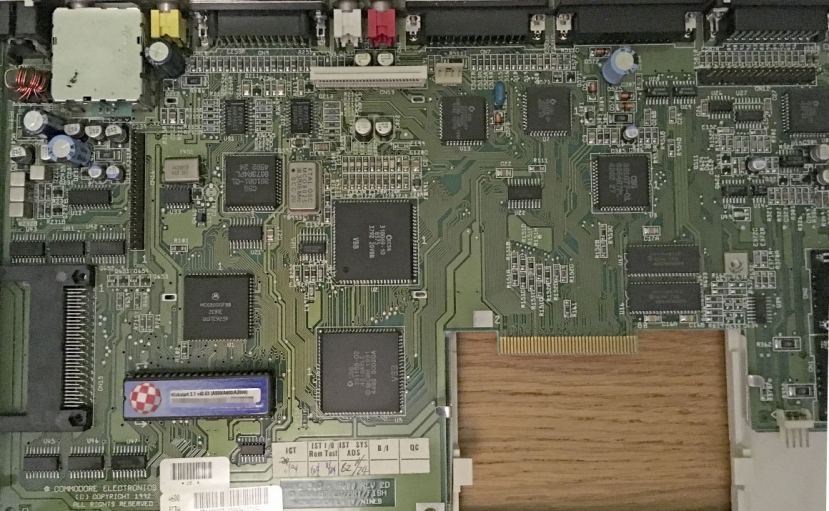
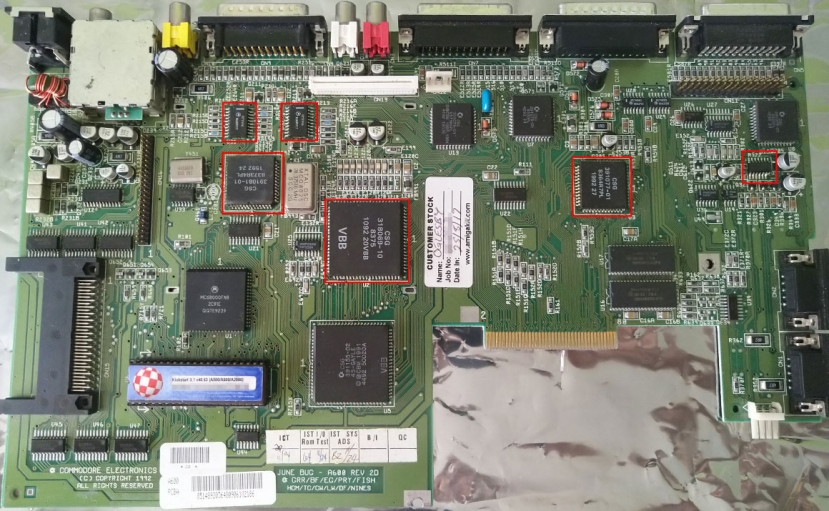
For legal reasons, I am not declaring every repair job carried out by AmigaKit is to this level of standard I received. I am only reporting and commentating on what I have personally experienced and what I can prove from email records. I have heard and read other customers have received excellent service from AmigaKit. I suspect my repair job was unique and if it wasn’t for the fact my Amiga decided to die, I suspect I would have received my Amiga back a lot earlier.
Conclusions
My experience with AmigaKit has been mixed. I’ve bought products from their website in the past and found the service to be very good, reliable and quick. To be fair, the quality of the repair and workmanship has been very good. To give credit where credit is due, AmigaKit did manage to repair the IDE connector by replacing it, recap and cleaning off the old fluid from the PCB (although I’ve not seen any evidence of old fluid) and replacing six chips to fix the video display issue, the last two issues for absolutely free.
Unfortunately, the original audio/sound distortion issue was never fully repaired. Instead of getting sound distortion and pops, I get minor sound distortion in the lower frequencies. The sound is better, but it isn’t perfect.
The only real fault I’ve found in AmigaKit is the lack of responsiveness to their communications. If AmigaKit were more proactive with them I doubt I wouldn’t have been as frustrated as I was. But we all know, emails, forums posts etc take time to write, time AmigaKit might not have if they have a backlog of repairs, orders etc.
The future
My beloved Amiga 600 is virtually brand new with all the new upgrades and repairs it has performed on it over the years. Here is a list of what has been done:
- Full Retrobright performed on the case and keys
- Capacitors were replaced twice and six chips replaced
- PCB clean-up (allegedly)
- The floppy disk drive was replaced as the original eventually failed
- The keyboard membrane was replaced as the original perished
- A604n 1MB chip memory expansion
- Real Time Clock module
- IDE Compact Flash adapter with Workbench 3.1 installed and other software
- EasyADF PCMCIA Compact Flash Transfer Kit
- Kickstart 3.1 ROM
The only thing left to purchase is an accelerator card. I did put my name down for the Vampire 2 card, but Apollo Accelerators increase the price on the card to the point I couldn’t justify the cost, so I didn’t get one when I was offered one. Instead, I’m interested in the Furia Amiga 600 Accelerator card by Lotharek, reading some good reviews for it.
The real question is, since I got back my Amiga board, have I gone back to playing 3D Construction Kit as it doesn’t have music? Not yet, but I’m planning on it :)
EDIT: Sept 2020
I have purchased a Furia Amiga 600 Accelerator card (at long last) and you can read all about, my experience, my frustrations and my joys. #Spoiler It’s brilliant.
Gallery
A collection of images of my Amiga project over the years. Click/touch on images to enlarge them.
- > 3D Construction Kit 1 and 2 for the Amiga. Both complete in box.
- > My Amiga before Retrobrighting. Notice the keys and the left hand side of the Amiga are yellow.
- > The keys and plastics have or are turning yellow.
- > My Amiga in the sunlight being Retrobrighted.
- > My Amiga after RetroBrighting procedure. Nice and white :)
- > Inside my Amiga 600, with the original Floppy Disk Drive, memory expansion and Real Time Clock. The only upgrades added at this time are the Kickstart ROM and IDE CompactFlash Hard Disk.
- > My Amiga 600 PCB motherboard before sending off to AmigaKit for repair.
- > This is the box package, with my Amiga PCB, which was sent to AmigaKit.
- > My Amiga 600 PCB Motherboard after repair from AmigaKit.
- My Amiga 600, 2023, with SD HD, WiFi, RGBtoHDMI, Furia 020 Accelerator card, 604n Memory Expansion with RealTime Clock.
- > I replaced the original orange hard disk LED with a red LED. Looks much better.
- > Inside my Amiga 600 with new upgrades: Floppy Disk Drive, A604n memory expansion with Real Time Clock, Kickstart ROM and IDE CompactFlash Hard Disk.

